Variable laminated timber
Montana State University School of Architecture
VLT Structure : research prototype for response to exterior conditions
Within architecture, wood products must be stable, predictable and consistent construction materials, typically resulting in flat or straight members. While upholding these construction values, this ongoing research offers an alternative laminated-timber approach that produces specific curved forms without the use of any formwork. Variable laminated timer (VLT) adjusts the grain direction (GD) and moisture content (MC) of “active layers” within the lamination assembly. Combined with the number and placement of active laminated timber layers (LL), the three variables generate a range of possible curvatures from a flat pressed lamination. This work aims to bypass needed formwork or moulds, like the ones used by Charles and Ray Eames and incorporate the anisotropic structure of wood, as well as the hydroscopic characteristics of wood as design variables to achieve specific curvatures. Unlike other successful curved laminated timber assemblies, VLT utilizes one species of dimensional lumber in the assembly for a more accessible transition from flat to curved wooden panels.
Small scale initial prototypes
The anisotropic nature of wood not only determines the optimal structural orientation but also the direction in which the material swells, stretches and shrinks in response to the internal change of MC. Wood has three natural orientations: longitudinal (L), radial (R), and tangential (T). The strongest structural orientation and least absorptive (0.01%) is L. Inversely the most absorptive (08%) orientation is T, with R in the middle (05%). Typically, cross laminated timber (CLT) is stacked with alternating GD at 90 degree to the previous and preceding layers so that the swelling of T is constrained by the stiffness of L in the neighboring layers. Laminations are a critical part in most large-scale timber construction and this constrained swelling consistently results in a predictable flat laminated panel. While consistency is key to implementing any construction technique within architecture, the rectilinear forms and flat panels are not.
vlt Subjects
Small-scale prototypes (subjects) using the same white oak species in a bilayer lamination with an area of 12cm x 34cm were developed to individually test the impact of each identified variable: GD, MC, and LL. To measure the transformation, all the subjects had points marked along the perimeter. The movement or translation of each point along the perimeter was recorded using a demential gridded surface to provide a delta X,Y,Z coordinate of the point. The transformed points were entered into a digital model to both simulate then measure the resulting curvature of the subjects.
VLT Subjects testing grain direction (GD)
Grain direction and major axis of timber
Measuring subject curvature
The subjects confirmed the direction of the resulting curvature is corresponds directly to the rotated GD angle in the lamination assembly. (fig. 02) By misaligning and angling the active layers, the swelling, stretching and shrinking of T is no longer constrained by the neighboring perpendicular stiffness of L and therefore can effect the global shape of the lamination. During the lamination process, layers are glued and pressed together and the glue increases the MC of both wood layers. As the laminations are released, the MC of the wood decreases as it dries and returns to the average of 10%, causing the wood in the lamination to effectively shrink. The most prominent and unconstrained shrinkage is along the T axis of the lamination layer with the rotated GD. The result is a global, self-curving process that conforms to a cylindrical monoclastic surface along the L axis of the active lamination layer with the rotated GD. Beyond the self-curving process of a same-species bilayer, the small-scale prototypes confirmed the GD angle is a reliable variable that determines the direction of the finished lamination’s monoclastic curved form. Two laminations of the same size and species, assembled on a flat surface, can have drastically different monoclastic forms according the angle of grain direction in the assembly (fig. 02).
Further, the subjects responded generally as expected to varying increased levels of MC. With higher MC levels during lamination, the subjects generally had a higher degrees of curvature after drying. However, there were some inconsistencies, including higher MC levels with less curvature. The relationship between MC and degrees of curvature requires either more testing or a different strategy for adjusting the MC. The added moisture amount was tested and determined as 10%, 12.5%, 15%, 17.5% and 20% of the to-be-active layer’s weight, and then sprayed onto the active layer.
As for the LL, there were clear trends with inconsistencies in-between them. Instead of a bilayer lamination, the LL tests consisted of three layers and tested each active (A) / non-active (N) lamination configuration. The most consistent and least curved LL was N-A-N. The remaining three were inconsistent, with A-A-N having the most curvature, while A-N-A and N-N-A reacted similarly. Like the MC, more testing, and even a different testing method is needed to verify these results.
In all cases, (GD, MC, and LL) the resulting curvature of the subjects was generally a monclastic curve resembling a cylinder, with the axis of the cylinder in the same or near same direction of the active layer L orientation.
VLT Samples:
This self-curving principle was tested with large scale samples using a series 10mm x 130mm profile western pine dimensional lumber so to simulate the industrial CLT process of laminating dimensional lumber. In addition to confirming the direction of the monoclastic curvature by altering the GD angle of the active lamination layers, the samples also aimed to produce differing degrees of curvature by altering the MC of the active layers. The thought and hope was the subjects were too small and thin to accurately test the MC, were larger wood elements like dimensional lumber would be saturated and respond more consistently. In order to test the relationship between MC and degrees of curvature, a series of different MC levels were obtained in active layers before lamination: 10% (average MC), 15% and 20%. Unlike the subjects, the active layers were soaked until the desired MC was reached, and once saturated, the elements were laminated with a non-active layer that had a normal MC of 10%. The resulting laminations (fig. 05) confirmed both the directional control of monoclastic curvature and the degree control of curvature through managing the MC of the active layer. Expectedly, the most extreme degrees of curvature resulted from the higher MC of 20%.
However, while the general degree of curvature was consistently related to the MC of the saturated rotated layer, the monoclastic curvature did not follow the shape of a cylinder but rather a cone, with some variation in-between. Further investigation is needed to explain the conic irregularity in the resulting curvature. It should also be noted that small gaps between lumber were noticed in the VLT with a saturated MC of 20%, meaning there are some structural compromises in favor of curved form for these particular VLT panels. Although curved surfaces do offer a more robust section modules, it is imperative all members are laminated together to function structurally.
VLT Structure:
Continued research is currently underway to both fully digitize and predict the curved VLT panels, and to test for any elastic change of global form from extreme weather. Because wood expands when wet, VLT could (theoretically) straighten itself again if the MC of the timber returns to the levels during lamination - perhaps from snow or rain. The structure outside Montana State University School of Architecture (Cheever Hall) will test this theory and give us some data on how much VLT will expand and shrink in response to the exterior environment. If the structure does respond, it may not be just an experiment on how much it moves, but the possibility of a living, responding structure. Contrarily, if the structure does not respond, it may be a viable exterior structural system.
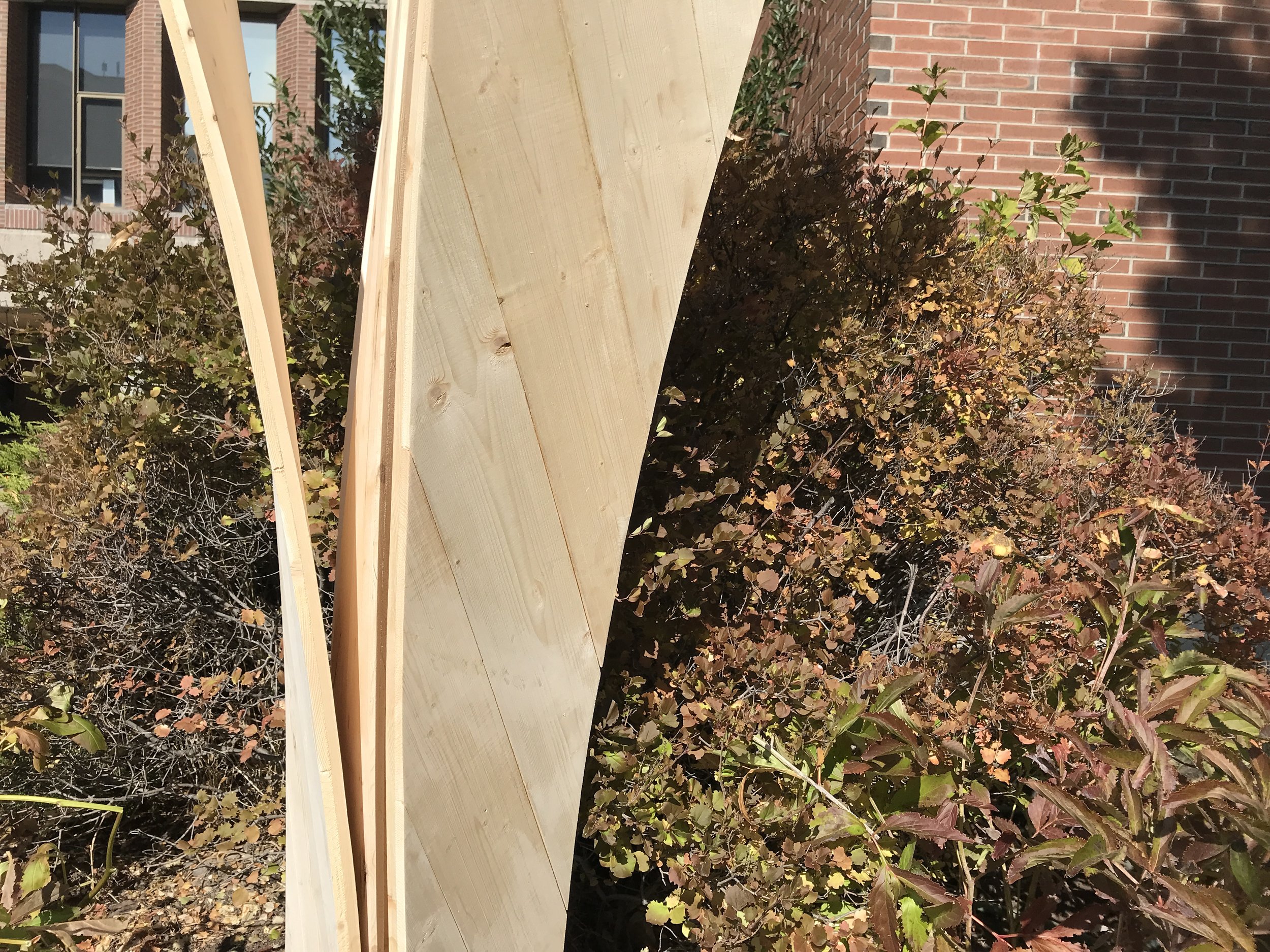
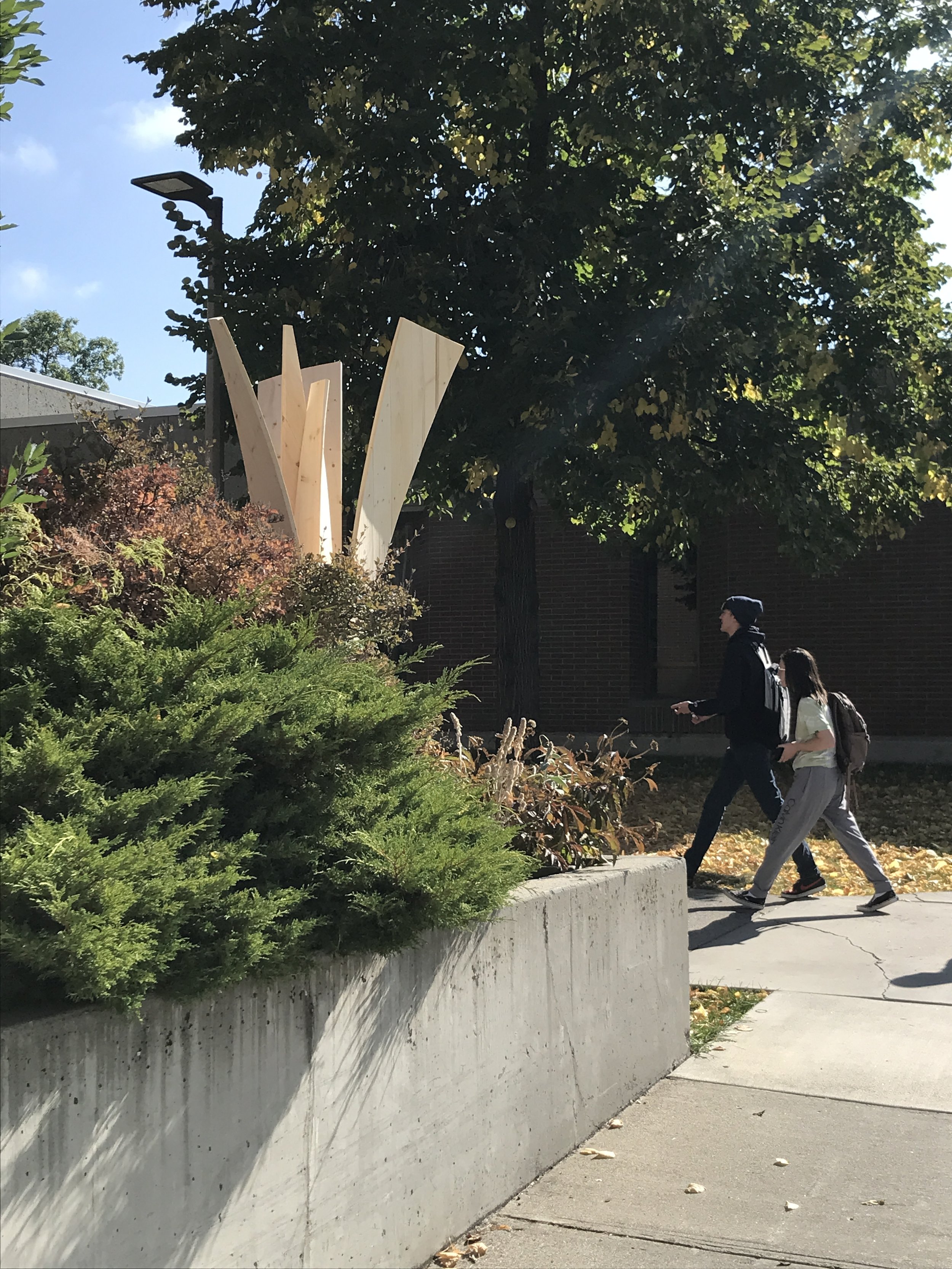
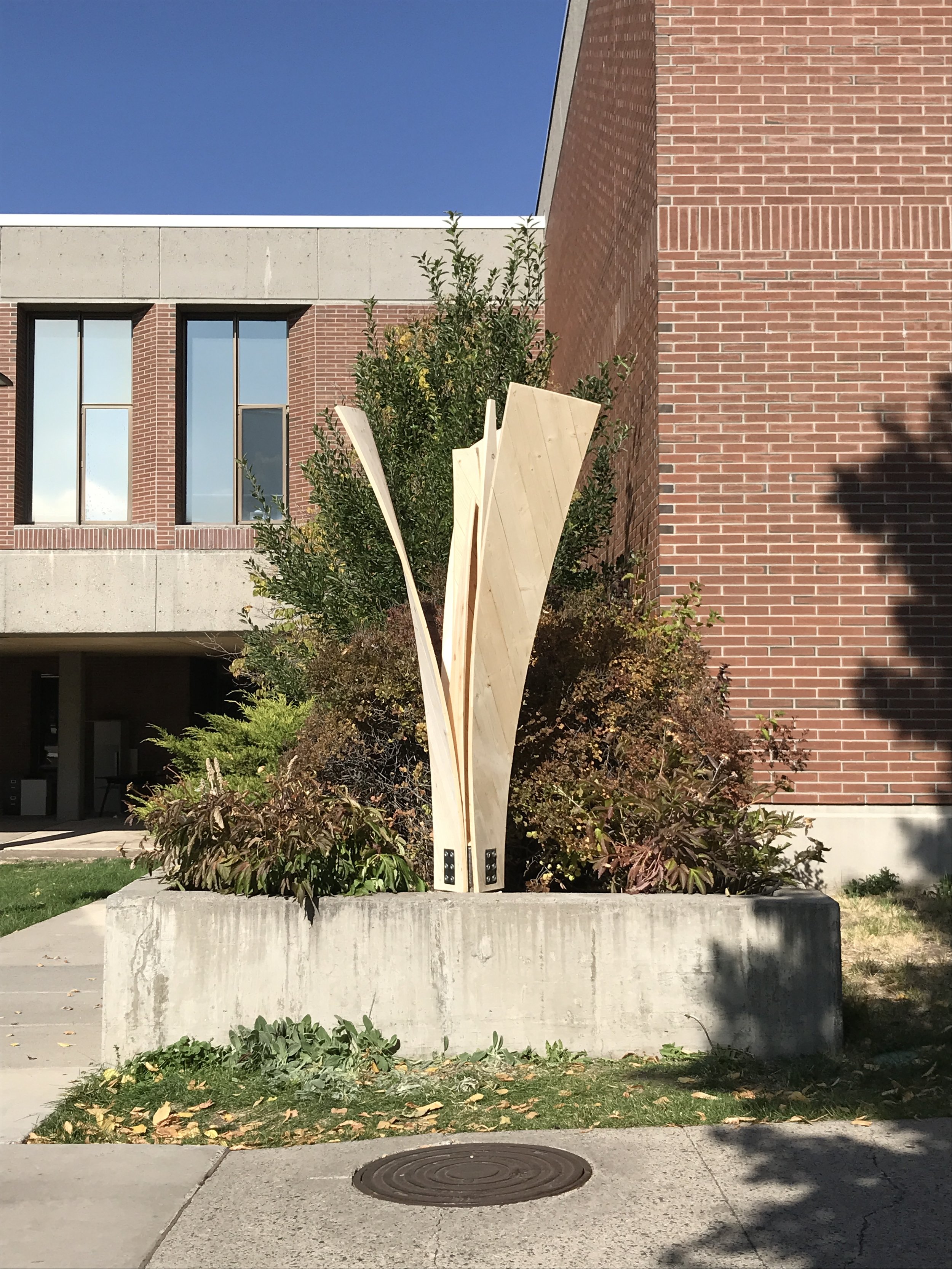
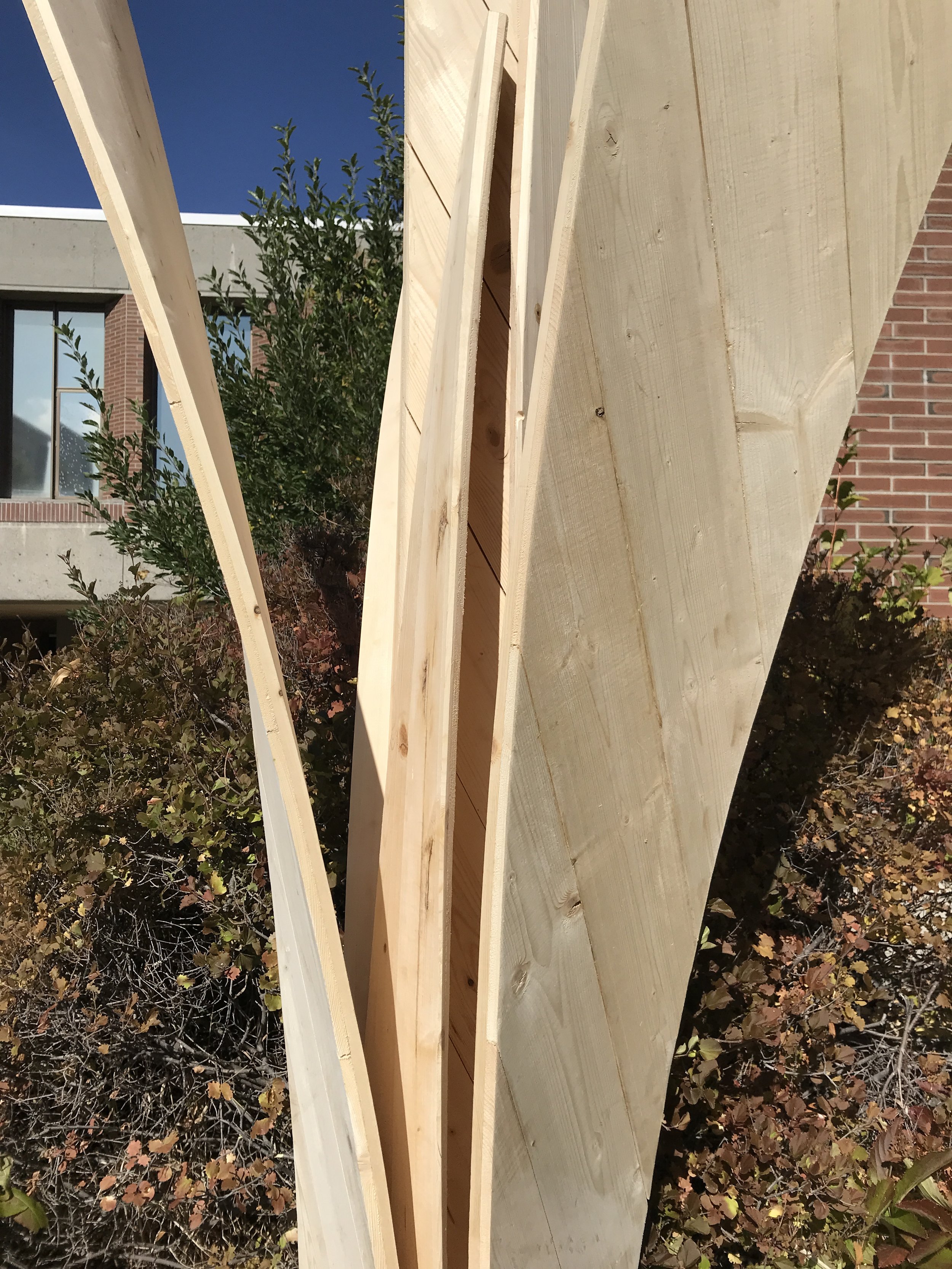
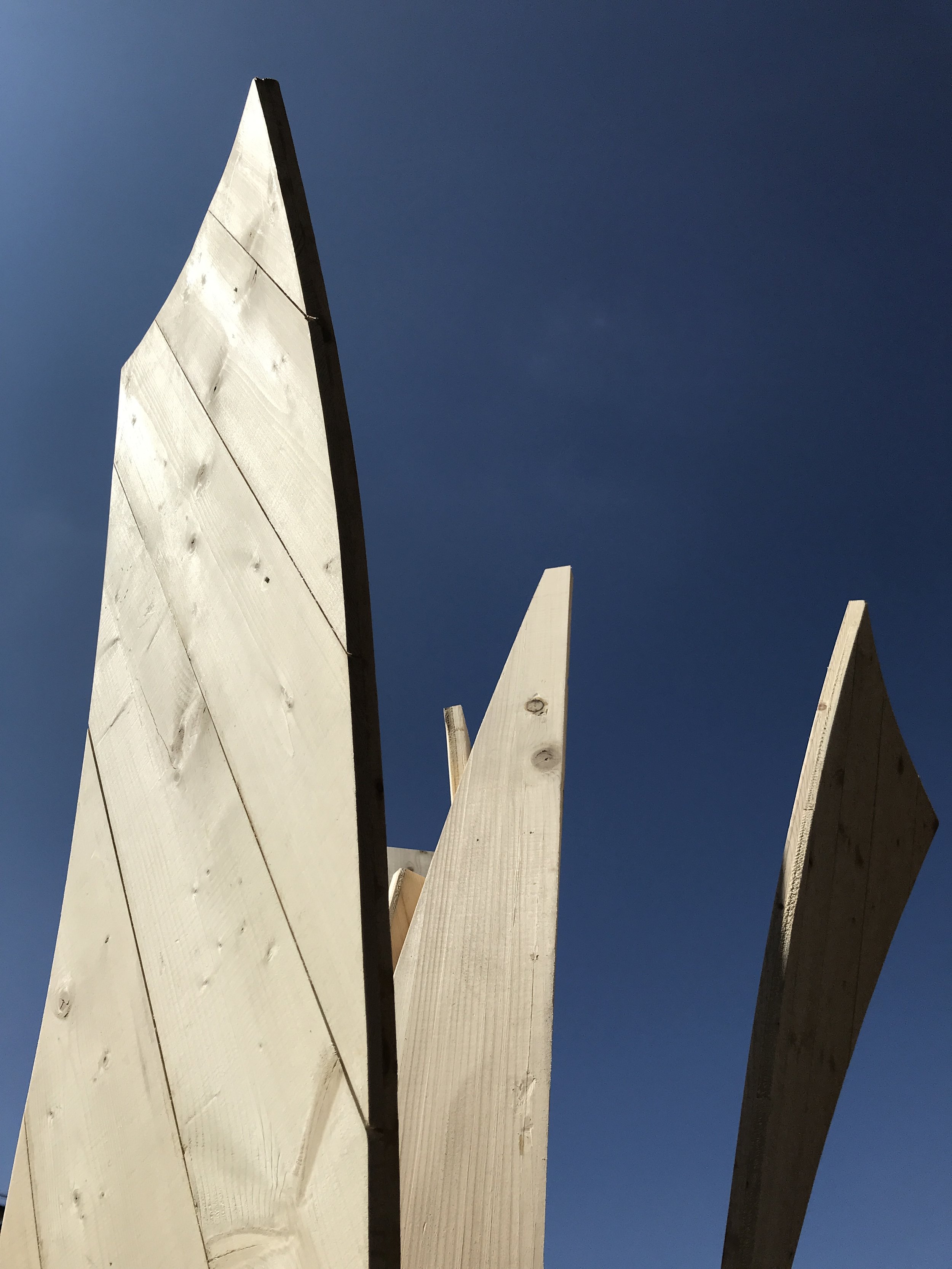
Conclusions:
The perception, performance and possibilities of VLT is far from finished. There is a lot of work to be done regarding the consistency of the identified variables at both small and large scales. We are comparing these results to full-scale prototypes in order to determine a predictable range of results depending on the variables, establish a scalar reciprocity between full and small scale prototypes, and produce a digital method for simulating the curved VLT form. Additionally, there are more areas of exploration including other species wood, the limiting effect of general panel size on degrees of curvature, potentially incorporating ‘green wood’ with 30% MC into panel assemblies instead of re-soaking the active layers and integrating aggregations of GD and MC for more complex curvature within one panel.
This exhibition aims to not only demonstrate and expose the process of controlling the GD, MC and LL within same species VLT to consistently produce a curved panel without the use of a complex curved formwork, but also begin speculating on the possibilities of curved wood forms based on their material properties, new construction methods based on predicted curvatures, and a new responsive architecture.







